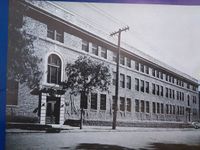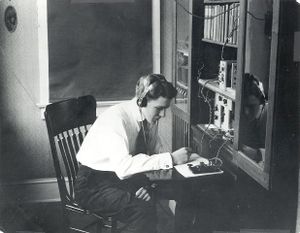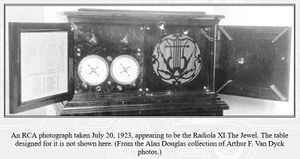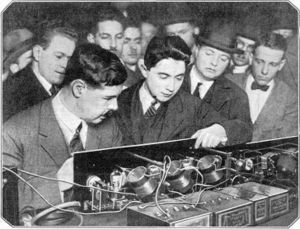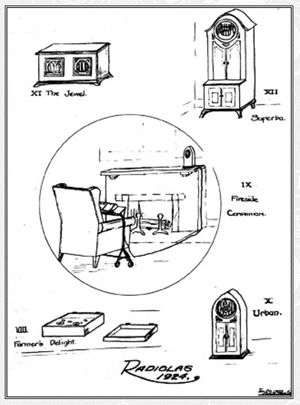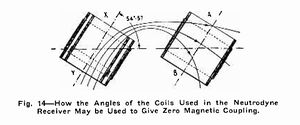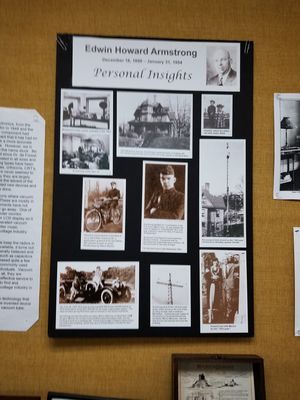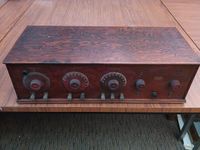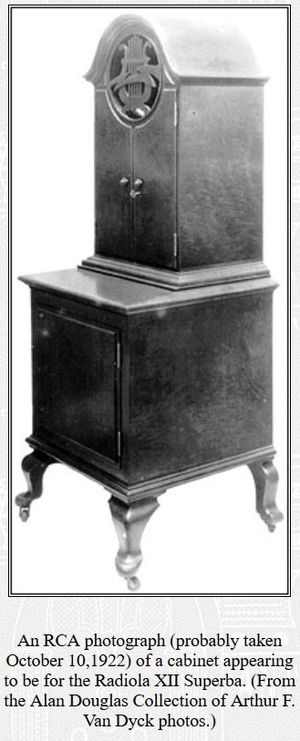Milestone-Proposal:Neutrodyne Circuit, 1922: Difference between revisions
No edit summary |
No edit summary |
||
| (22 intermediate revisions by 3 users not shown) | |||
| Line 6: | Line 6: | ||
|benefit to humanity=Yes | |benefit to humanity=Yes | ||
|regional importance=Yes | |regional importance=Yes | ||
|ou is paying= | |ou is paying=Yes | ||
|ou is arranging dedication= | |ou is arranging dedication=Yes | ||
|section is taking responsibility for plaque= | |section is taking responsibility for plaque=Yes | ||
|a11= | |a11=Yes | ||
|a3=1922 | |a3=1922 | ||
|a1= | |a1=Neutrodyne Circuit, 1922 | ||
|plaque citation=The Neutrodyne Circuit | |plaque citation=The Neutrodyne Circuit, invented near this site in 1922, used neutralizing capacitors to eliminate squeals from parasitic oscillation that plagued early radios. Improved clarity of reception and easier tuning facilitated broader radio adoption by the general public. Multiple manufacturers licensed the circuit to make affordable consumer products, expanding the marketplace from amateur radio operators into a mass consumer market for news, information, music, and culture. | ||
|a2b=IEEE North Jersey Section | |a2b=IEEE North Jersey Section | ||
|IEEE units paying={{IEEE Organizational Unit Paying | |IEEE units paying={{IEEE Organizational Unit Paying | ||
| Line 26: | Line 26: | ||
|Proposer name=Kit August | |Proposer name=Kit August | ||
|Proposer email=kit@ieee.org | |Proposer email=kit@ieee.org | ||
}}{{Milestone proposer | |||
|Proposer name=Victor Lawrence | |||
|Proposer email=victor.lawrence@stevens.edu | |||
}}{{Milestone proposer | |||
|Proposer name=Isabelle Engel | |||
|Proposer email=isabelle.engel@gmail.com | |||
}} | }} | ||
|a2a=40. | |a2a=40.742287, -74.027778, The Edwin A. Stevens building, Stevens Institute of Technology, 5th Street between Hudson and River Sts, Hoboken, New Jersey, U.S.A. The building is listed on the New Jersey and the National Register of Historic Places. The plaque will be inside the front entrance of the building, which is only a few hundred meters from the location of the former laboratory where the Neutrodyne was invented. | ||
|a7=The intended site | |a7=The intended site is the Edwin A. Stevens building. The building is one of the oldest academic buildings on the Stevens campus. The building is listed on the New Jersey and the National Register of Historic Places. The plaque will be inside the front entrance of the building, which is only a few hundred meters from the location of the former laboratory where the Neutrodyne was invented. | ||
|a8=No. The Navy Building was demolished in February 1981. The site is now occupied by the Babbio Center. The original building where Hazeltine's laboratory was located was the Electrical Engineering Building of Stevens Institute of Technology, Hoboken, NJ, where Hazeltine was head of the E.E. department. The building was originally the World War I large Navy Building at 521 River St. Hazeltine's office was in the south west corner of the 2nd floor. Other offices, classrooms, laboratories, and the model shop occupied the rest of the first and second floors. (source: ''The Early Days of Wheeler and Hazeltine Corporation'', pg. 86). [[File:Navy_building.jpg|200px|thumb|right|Navy Building looking southeast along river street]] | |a8=No. The Navy Building was demolished in February 1981. The site is now occupied by the Babbio Center. The original building where Hazeltine's laboratory was located was the Electrical Engineering Building of Stevens Institute of Technology, Hoboken, NJ, where Hazeltine was head of the E.E. department. The building was originally the World War I large Navy Building at 521 River St. Hazeltine's office was in the south west corner of the 2nd floor. Other offices, classrooms, laboratories, and the model shop occupied the rest of the first and second floors. (source: ''The Early Days of Wheeler and Hazeltine Corporation'', pg. 86). [[File:Navy_building.jpg|200px|thumb|right|Navy Building looking southeast along river street]] | ||
|mounting details= | |mounting details=The plaque will be mounted in the ground floor entrance hall. | ||
|a9=The building is open to the public weekdays between 9 A.M. and 9 P.M. | |||
|a10=Stevens Institute of Technology | |a10=Stevens Institute of Technology | ||
|a4=In the autumn of 1922, Prof Alan Hazeltine designed a receiver using a Tuned Radio Frequency amplifier. Joseph Freed of the Freed-Eisemann Radio Corp. built the first model from plans supplied by Hazeltine. Hazeltine demonstrated the receiver on 2 March 1923 at a meeting of the Radio Club of America at Columbia University, New York City. Hazeltine Corporation stock began trading on 1 February 1924 on the Curb Exchange (now the AMEX). [[File:Neutrodyne_Receiver.jpg|200px|thumb|right|A Hazeltine Neutrodyne receiver]] | |a4=[[File:Wheeler Radio0076.jpg|thumb]] | ||
[[File:RCA1923RadiolaTheJewel.jpg|thumb]] | |||
[[File:First neutrodyne radio receiver-Columbia.jpg|thumb]] | |||
[[File:RCA1923.jpg|thumb]] | |||
[[Image:HowAnglesNeutrodyneGiveZeroMagneticCoupling.jpg|thumb]] | |||
[[Image:EdwinHowardArmstrong-Insights-Poster-20180609 160005.jpg|thumb]] | |||
The Neutrodyne Circuit invented on this site in 1922 in the Navy Building in the laboratory of Professor Louis Alan Hazeltine with Harold A Wheeler and others, enabled affordably easier to tune radios and neutralized capacitors eliminating squeals from parasitic oscillation previously plaguing radio receivers and amplifiers. These improvements in performance and simplicity rapidly expanded radio use from amateur radio operators to usher in a mass communication consumer market. In 1923, 500 stations were broadcasting to about two million listeners; Neutrodyne was licensed to 20 manufacturers, expanded ownership by 10 million affordable radios, an increase from 10 to 60% of the population of North America and impact on how individuals receive information, music and culture – transforming opportunities for everyone – with enduring effects evident in our everyday lives. Many have noted the inspiration of Professor Armstrong and his more expensive RCA solutions; what is important to note about this 'inspiration' and the unique Neutrodyne solution, is that the Neutrodyne team sought specifically to Democratize access to Technology which serves Humanity. Radio Democratized Politics and so many other opportunities. The Neutrodyne team quickly provided licenses to 20 companies rather than to create a complex expensive solution as RCA chose to do. Armstrong's super heterodyne and regenerative circuits solution for RCA was kept proprietary and expensive, which created disparity between wealthy and everybody else. Because of Neutrodyne, in 1923 and 1924 the entire product line proposed by RCA was halted (proposed product catalog included in references) and the Chicago Radio Show offered many new more affordable products creating opportunities for businesses, broadcasters, stimulating commerce, consumers, regular people for the very first time. In this way for the first time, regular people all over North America had access to Politics of the day, became educated about many things, heard music, entertainment, learned about the latest news, etc. Previously, only 10 percent of the population had access. With Neutrodyne, in three years, 60 percent had access. Mass communication. Not just for the wealthy. Regular people could learn and hear politics of their day and engage in the culture of their time in a meaningful way. This was a major transformative influence on society lasting to the present time. In the autumn of 1922, Prof Alan Hazeltine designed a receiver using a Tuned Radio Frequency amplifier. Joseph Freed of the Freed-Eisemann Radio Corp. built the first model from plans supplied by Hazeltine. Hazeltine demonstrated the receiver on 2 March 1923 at a meeting of the Radio Club of America at Columbia University, New York City. Patent US1450080 issued to Hazeltine on 27 March 1923, and Hazeltine Corporation stock began trading on 1 February 1924 on the Curb Exchange (now the AMEX). [[File:Neutrodyne_Receiver.jpg|200px|thumb|right|A Hazeltine Neutrodyne receiver]] | |||
The Neutrodyne was a ''circuit with an extra capacitor and two coils, which could completely stabilize a radio frequency amplifier. The circuit was usually designed with three tuned circuits and three dials, including two stages of radio frequency (RF) amplification and a tuned detector. Since a nonregenerative detector was used, the circuit was free of patent infringement.'' | The Neutrodyne was a ''circuit with an extra capacitor and two coils, which could completely stabilize a radio frequency amplifier. The circuit was usually designed with three tuned circuits and three dials, including two stages of radio frequency (RF) amplification and a tuned detector. Since a nonregenerative detector was used, the circuit was free of patent infringement.'' | ||
''To reduce magnetic coupling between the tuning coils, the three coils were assembled at a critical angle, mathematically derived by Hazeltine as 54.7 degrees. The three dials and the coils at this angle identified a 'Neutrodyne' receiver. The first sets were produced by Freed-Eisemann Radio Corporation in 1923, and soon there were a number of licensees paying royalties to Hazeltine. He founded a research and consulting service, and was President of the IRE (Institute of Radio Engineers) in 1936'' -- John Ryder and Donald Fink, ''Engineers & Electrons'', 1984, IEEE Press, p 76 | ''To reduce magnetic coupling between the tuning coils, the three coils were assembled at a critical angle, mathematically derived by Hazeltine as 54.7 degrees. The three dials and the coils at this angle identified a 'Neutrodyne' receiver. The first sets were produced by Freed-Eisemann Radio Corporation in 1923, and soon there were a number of licensees paying royalties to Hazeltine. He founded a research and consulting service, and was President of the IRE (Institute of Radio Engineers) in 1936'' -- John Ryder and Donald Fink, ''Engineers & Electrons'', 1984, IEEE Press, p 76 | ||
[https:// | <br><br>Detail of [https://ethw.org/File:Neutrodyne_Receiver_detail.jpg receiver with Hazeltine stamp]<br><br> | ||
[https:// | Detail of receiver showing [https://ethw.org/File:Neutrodyne_Receiver_detail_of_dials.jpg Dials] | ||
|a6=''To increase the ability of their [radio] receivers to pick up long-distance signals, some manufacturers included a stage of amplification ahead of the regenerative detector circuit. This made the circuit adjustment even more critical than in the regenerative detector alone, as internal feedback of signal allowed the first amplifier to become a potential oscillator, producing more receiver squeals''-- John Ryder and Donald Fink, ''Engineers & Electrons'', 1984, IEEE Press, p. 76 In particular, the majority of radio work was theoretical and Professor Hazeltine employed experimental processes to determine angles and frequencies resulting in the reduction of parasitic oscillation, also creating a 'standard' for the industry. Devices could be manufactured inexpensively because of the coil design and standard configurations. Elegant and excellent solutions utilizing experimental techniques not previously employed in the field. | |||
|a5=Prior to the invention of the Neutrodyne Circuit, radio receivers were extremely difficult to tune. This was due to an amplifier placed before the regenerative detector circuit which, when tuned incorrectly, would begin to oscillate and produce receiver “squeals”. The “Super Heterodyne” solved this problem, but RCA’s monopoly on the solution made implementing the technology prohibitively expensive for most amateur radio operators. | |||
Unlike most radio receivers of the day, the Neutrodyne Circuit utilized an extra capacitor and two coils. Unlike the Super Heterodyne, the Neutrodyne leveraged a nonregenerative detector, so it did not infringe on RCA’s intellectual property. Additionally, to reduce magnetic coupling between the two capacitors, the capacitors in a Neutrodyne are placed at 54.7 degree angles. These distinct features produced radio receivers that could be easily tuned and did not require extensive training to operate. | |||
Hazeltine then licensed this technology to 20 different radio manufacturers. This meant that Neutrodyne receivers could be mass produced and sold at a price that was accessible to the average American. Due to the ease of operation and affordable price of Neutrodyne receivers, consumer radio ownership grew from 10% of Americans in 1923 to 60% in 1927. This unique combination meant the Neutrodyne circuit brought radio technology to the masses. | |||
|references=1) Hazeltine, L. A., "Tuned Radio-Frequency Amplification with Neutralization of Capacity Coupling," (a paper presented before the Radio Club of America), ''QST,'' 2 March 1923 | |||
2) Dreyer, J. F., "How to Build a Neutrodyne Set," ''Popular Science Monthly,'' March 1924, pp 73, 1546-149 | |||
3) Dodds, Lawrence B., "Louis Hazeltine--A Human Professor," ''Stevens Indicator'', Fall 1979/Winter1980 pg 19. | |||
[https:// | 4) [https://law.justia.com/cases/federal/district-courts/F2/21/643/1510208/ Hazeltine Corporation v. AH Grebe & Co.] 21 F.2d643 (E.D.N.Y. 1927) | ||
5) [https://law.justia.com/cases/federal/district-courts/F2/52/504/1500119/ Hazeltine Corporation v. Radio Corporation of America,] 42 F.2d 504 (S.D.N.Y.) | |||
Wheeler, Harold Alden, ''The Early Days of Wheeler and Hazeltine Corporation -- Profiles in Radio and Electronics," 1982, Greenlawn, N.Y. | 6) Molnar, Mike, "Hazeltine, the Neutrodyne, and the Hazeltine Corporation," ''Antique Wireless Association Review'', 2013, Vol. 26 (a copy of this article is on file at the History Center for reference by the proposers and the advocate) | ||
|supporting materials=[http://ieeemilestones.ethw.org/File:Hazeltine_article_on_Neutrodyne_Receiver.pdf Hazeltine, L. A., "The Neutrodyne Receiver", 1923 ''The Stute''] | |||
7) Ryder, John and Fink, Donald, ''Engineers & Electrons'', 1984 IEEE Press, pg 76. (The entire book is online at the URL below) | |||
8) [https://ethw.org/File:US1450080_Hazeltine_Neutrodyne_Patent.pdf US1450080 Hazeltine's Neutrodyne Patent] issued 27 March 1923 | |||
9) Wheeler, Harold A. ''Hazeltine the Professor'', 1978, Greenlawn, N.Y. | |||
10) Wheeler, Harold Alden, ''The Early Days of Wheeler and Hazeltine Corporation -- Profiles in Radio and Electronics," 1982, Greenlawn, N.Y. | |||
|supporting materials=[[Image:RCA1922RadiolaXIISuperba.jpg|thumb]] | |||
[http://ieeemilestones.ethw.org/File:Hazeltine_article_on_Neutrodyne_Receiver.pdf Hazeltine, L. A., "The Neutrodyne Receiver", 1923 ''The Stute''] | |||
[[Media:NRI-Lesson-20-Neutrodyne-Receiver.pdf|National Radio Institute - The Neutrodyne Receiver]] | |||
| Line 61: | Line 97: | ||
[https://ethw.org/Alan_Hazeltine Biography of Alan Hazeltine] | [https://ethw.org/Alan_Hazeltine Biography of Alan Hazeltine] | ||
|submitted= | |||
[https://youtu.be/HaqqXZbNrJU IEEE Showcase - Futurecast - Neutrodyne Milestone Video] | |||
[[Media:ElectionRadioSoundBites-DemocratizingPolitics-1924.pdf|"Speeches Must Be Short: Radio and the Birth of the Modern Presidential Campaign"]], Pacific Standard, Oct 2 2012 | |||
[[Media:AntiqueRadioClassified-1999-RCAandPricelist1923.pdf|"RCA's Intended Models for the 1923-1924 Season "What Might Have Been"]], Antique Radio Classified, June 1999 | |||
|submitted=Yes | |||
}} | }} | ||
Revision as of 14:25, 3 October 2019
To see comments, or add a comment to this discussion, click here.
Docket #:2019-02
This Proposal has been approved, and is now a Milestone
To the proposer’s knowledge, is this achievement subject to litigation? No
Is the achievement you are proposing more than 25 years old? Yes
Is the achievement you are proposing within IEEE’s designated fields as defined by IEEE Bylaw I-104.11, namely: Engineering, Computer Sciences and Information Technology, Physical Sciences, Biological and Medical Sciences, Mathematics, Technical Communications, Education, Management, and Law and Policy. Yes
Did the achievement provide a meaningful benefit for humanity? Yes
Was it of at least regional importance? Yes
Has an IEEE Organizational Unit agreed to pay for the milestone plaque(s)? Yes
Has the IEEE Section(s) in which the plaque(s) will be located agreed to arrange the dedication ceremony? Yes
Has the IEEE Section in which the milestone is located agreed to take responsibility for the plaque after it is dedicated? Yes
Has the owner of the site agreed to have it designated as an IEEE Milestone? Yes
Year or range of years in which the achievement occurred:
1922
Title of the proposed milestone:
Neutrodyne Circuit, 1922
Plaque citation summarizing the achievement and its significance; if personal name(s) are included, such name(s) must follow the achievement itself in the citation wording: Text absolutely limited by plaque dimensions to 70 words; 60 is preferable for aesthetic reasons.
The Neutrodyne Circuit, invented near this site in 1922, used neutralizing capacitors to eliminate squeals from parasitic oscillation that plagued early radios. Improved clarity of reception and easier tuning facilitated broader radio adoption by the general public. Multiple manufacturers licensed the circuit to make affordable consumer products, expanding the marketplace from amateur radio operators into a mass consumer market for news, information, music, and culture.
200-250 word abstract describing the significance of the technical achievement being proposed, the person(s) involved, historical context, humanitarian and social impact, as well as any possible controversies the advocate might need to review.
IEEE technical societies and technical councils within whose fields of interest the Milestone proposal resides.
In what IEEE section(s) does it reside?
IEEE North Jersey Section
IEEE Organizational Unit(s) which have agreed to sponsor the Milestone:
IEEE Organizational Unit(s) paying for milestone plaque(s):
Unit: IEEE North Jersey Section
Senior Officer Name: {{{Senior officer name}}}
IEEE Organizational Unit(s) arranging the dedication ceremony:
Unit: IEEE North Jersey Section
Senior Officer Name: {{{Senior officer name}}}
IEEE section(s) monitoring the plaque(s):
Milestone proposer(s):
Proposer name: Matt Tomaro
Proposer email: Proposer's email masked to public
Proposer name: Kit August
Proposer email: Proposer's email masked to public
Proposer name: Victor Lawrence
Proposer email: Proposer's email masked to public
Proposer name: Isabelle Engel
Proposer email: Proposer's email masked to public
Please note: your email address and contact information will be masked on the website for privacy reasons. Only IEEE History Center Staff will be able to view the email address.
Street address(es) and GPS coordinates in decimal form of the intended milestone plaque site(s):
40.742287, -74.027778, The Edwin A. Stevens building, Stevens Institute of Technology, 5th Street between Hudson and River Sts, Hoboken, New Jersey, U.S.A. The building is listed on the New Jersey and the National Register of Historic Places. The plaque will be inside the front entrance of the building, which is only a few hundred meters from the location of the former laboratory where the Neutrodyne was invented.
Describe briefly the intended site(s) of the milestone plaque(s). The intended site(s) must have a direct connection with the achievement (e.g. where developed, invented, tested, demonstrated, installed, or operated, etc.). A museum where a device or example of the technology is displayed, or the university where the inventor studied, are not, in themselves, sufficient connection for a milestone plaque.
Please give the details of the mounting, i.e. on the outside of the building, in the ground floor entrance hall, on a plinth on the grounds, etc. If visitors to the plaque site will need to go through security, or make an appointment, please give the contact information visitors will need. The intended site is the Edwin A. Stevens building. The building is one of the oldest academic buildings on the Stevens campus. The building is listed on the New Jersey and the National Register of Historic Places. The plaque will be inside the front entrance of the building, which is only a few hundred meters from the location of the former laboratory where the Neutrodyne was invented.
Are the original buildings extant?
No. The Navy Building was demolished in February 1981. The site is now occupied by the Babbio Center. The original building where Hazeltine's laboratory was located was the Electrical Engineering Building of Stevens Institute of Technology, Hoboken, NJ, where Hazeltine was head of the E.E. department. The building was originally the World War I large Navy Building at 521 River St. Hazeltine's office was in the south west corner of the 2nd floor. Other offices, classrooms, laboratories, and the model shop occupied the rest of the first and second floors. (source: The Early Days of Wheeler and Hazeltine Corporation, pg. 86).
Details of the plaque mounting:
The plaque will be mounted in the ground floor entrance hall.
How is the site protected/secured, and in what ways is it accessible to the public?
The building is open to the public weekdays between 9 A.M. and 9 P.M.
Who is the present owner of the site(s)?
Stevens Institute of Technology
What is the historical significance of the work (its technological, scientific, or social importance)? If personal names are included in citation, include detailed support at the end of this section preceded by "Justification for Inclusion of Name(s)". (see section 6 of Milestone Guidelines)
The Neutrodyne Circuit invented on this site in 1922 in the Navy Building in the laboratory of Professor Louis Alan Hazeltine with Harold A Wheeler and others, enabled affordably easier to tune radios and neutralized capacitors eliminating squeals from parasitic oscillation previously plaguing radio receivers and amplifiers. These improvements in performance and simplicity rapidly expanded radio use from amateur radio operators to usher in a mass communication consumer market. In 1923, 500 stations were broadcasting to about two million listeners; Neutrodyne was licensed to 20 manufacturers, expanded ownership by 10 million affordable radios, an increase from 10 to 60% of the population of North America and impact on how individuals receive information, music and culture – transforming opportunities for everyone – with enduring effects evident in our everyday lives. Many have noted the inspiration of Professor Armstrong and his more expensive RCA solutions; what is important to note about this 'inspiration' and the unique Neutrodyne solution, is that the Neutrodyne team sought specifically to Democratize access to Technology which serves Humanity. Radio Democratized Politics and so many other opportunities. The Neutrodyne team quickly provided licenses to 20 companies rather than to create a complex expensive solution as RCA chose to do. Armstrong's super heterodyne and regenerative circuits solution for RCA was kept proprietary and expensive, which created disparity between wealthy and everybody else. Because of Neutrodyne, in 1923 and 1924 the entire product line proposed by RCA was halted (proposed product catalog included in references) and the Chicago Radio Show offered many new more affordable products creating opportunities for businesses, broadcasters, stimulating commerce, consumers, regular people for the very first time. In this way for the first time, regular people all over North America had access to Politics of the day, became educated about many things, heard music, entertainment, learned about the latest news, etc. Previously, only 10 percent of the population had access. With Neutrodyne, in three years, 60 percent had access. Mass communication. Not just for the wealthy. Regular people could learn and hear politics of their day and engage in the culture of their time in a meaningful way. This was a major transformative influence on society lasting to the present time. In the autumn of 1922, Prof Alan Hazeltine designed a receiver using a Tuned Radio Frequency amplifier. Joseph Freed of the Freed-Eisemann Radio Corp. built the first model from plans supplied by Hazeltine. Hazeltine demonstrated the receiver on 2 March 1923 at a meeting of the Radio Club of America at Columbia University, New York City. Patent US1450080 issued to Hazeltine on 27 March 1923, and Hazeltine Corporation stock began trading on 1 February 1924 on the Curb Exchange (now the AMEX).
The Neutrodyne was a circuit with an extra capacitor and two coils, which could completely stabilize a radio frequency amplifier. The circuit was usually designed with three tuned circuits and three dials, including two stages of radio frequency (RF) amplification and a tuned detector. Since a nonregenerative detector was used, the circuit was free of patent infringement.
To reduce magnetic coupling between the tuning coils, the three coils were assembled at a critical angle, mathematically derived by Hazeltine as 54.7 degrees. The three dials and the coils at this angle identified a 'Neutrodyne' receiver. The first sets were produced by Freed-Eisemann Radio Corporation in 1923, and soon there were a number of licensees paying royalties to Hazeltine. He founded a research and consulting service, and was President of the IRE (Institute of Radio Engineers) in 1936 -- John Ryder and Donald Fink, Engineers & Electrons, 1984, IEEE Press, p 76
Detail of receiver with Hazeltine stamp
Detail of receiver showing Dials
What obstacles (technical, political, geographic) needed to be overcome?
To increase the ability of their [radio] receivers to pick up long-distance signals, some manufacturers included a stage of amplification ahead of the regenerative detector circuit. This made the circuit adjustment even more critical than in the regenerative detector alone, as internal feedback of signal allowed the first amplifier to become a potential oscillator, producing more receiver squeals-- John Ryder and Donald Fink, Engineers & Electrons, 1984, IEEE Press, p. 76 In particular, the majority of radio work was theoretical and Professor Hazeltine employed experimental processes to determine angles and frequencies resulting in the reduction of parasitic oscillation, also creating a 'standard' for the industry. Devices could be manufactured inexpensively because of the coil design and standard configurations. Elegant and excellent solutions utilizing experimental techniques not previously employed in the field.
What features set this work apart from similar achievements?
Prior to the invention of the Neutrodyne Circuit, radio receivers were extremely difficult to tune. This was due to an amplifier placed before the regenerative detector circuit which, when tuned incorrectly, would begin to oscillate and produce receiver “squeals”. The “Super Heterodyne” solved this problem, but RCA’s monopoly on the solution made implementing the technology prohibitively expensive for most amateur radio operators. Unlike most radio receivers of the day, the Neutrodyne Circuit utilized an extra capacitor and two coils. Unlike the Super Heterodyne, the Neutrodyne leveraged a nonregenerative detector, so it did not infringe on RCA’s intellectual property. Additionally, to reduce magnetic coupling between the two capacitors, the capacitors in a Neutrodyne are placed at 54.7 degree angles. These distinct features produced radio receivers that could be easily tuned and did not require extensive training to operate. Hazeltine then licensed this technology to 20 different radio manufacturers. This meant that Neutrodyne receivers could be mass produced and sold at a price that was accessible to the average American. Due to the ease of operation and affordable price of Neutrodyne receivers, consumer radio ownership grew from 10% of Americans in 1923 to 60% in 1927. This unique combination meant the Neutrodyne circuit brought radio technology to the masses.
Why was the achievement successful and impactful?
Supporting texts and citations to establish the dates, location, and importance of the achievement: Minimum of five (5), but as many as needed to support the milestone, such as patents, contemporary newspaper articles, journal articles, or chapters in scholarly books. 'Scholarly' is defined as peer-reviewed, with references, and published. You must supply the texts or excerpts themselves, not just the references. At least one of the references must be from a scholarly book or journal article. All supporting materials must be in English, or accompanied by an English translation.
1) Hazeltine, L. A., "Tuned Radio-Frequency Amplification with Neutralization of Capacity Coupling," (a paper presented before the Radio Club of America), QST, 2 March 1923
2) Dreyer, J. F., "How to Build a Neutrodyne Set," Popular Science Monthly, March 1924, pp 73, 1546-149
3) Dodds, Lawrence B., "Louis Hazeltine--A Human Professor," Stevens Indicator, Fall 1979/Winter1980 pg 19.
4) Hazeltine Corporation v. AH Grebe & Co. 21 F.2d643 (E.D.N.Y. 1927)
5) Hazeltine Corporation v. Radio Corporation of America, 42 F.2d 504 (S.D.N.Y.)
6) Molnar, Mike, "Hazeltine, the Neutrodyne, and the Hazeltine Corporation," Antique Wireless Association Review, 2013, Vol. 26 (a copy of this article is on file at the History Center for reference by the proposers and the advocate)
7) Ryder, John and Fink, Donald, Engineers & Electrons, 1984 IEEE Press, pg 76. (The entire book is online at the URL below)
8) US1450080 Hazeltine's Neutrodyne Patent issued 27 March 1923
9) Wheeler, Harold A. Hazeltine the Professor, 1978, Greenlawn, N.Y.
10) Wheeler, Harold Alden, The Early Days of Wheeler and Hazeltine Corporation -- Profiles in Radio and Electronics," 1982, Greenlawn, N.Y.
Supporting materials (supported formats: GIF, JPEG, PNG, PDF, DOC): All supporting materials must be in English, or if not in English, accompanied by an English translation. You must supply the texts or excerpts themselves, not just the references. For documents that are copyright-encumbered, or which you do not have rights to post, email the documents themselves to ieee-history@ieee.org. Please see the Milestone Program Guidelines for more information.
Hazeltine, L. A., "The Neutrodyne Receiver", 1923 The Stute
National Radio Institute - The Neutrodyne Receiver
Ryder, John and Fink, Donald, Engineers & Electrons, 1984 IEEE Press, pg 76.
IEEE Showcase - Futurecast - Neutrodyne Milestone Video
"Speeches Must Be Short: Radio and the Birth of the Modern Presidential Campaign", Pacific Standard, Oct 2 2012
"RCA's Intended Models for the 1923-1924 Season "What Might Have Been", Antique Radio Classified, June 1999
Please email a jpeg or PDF a letter in English, or with English translation, from the site owner(s) giving permission to place IEEE milestone plaque on the property, and a letter (or forwarded email) from the appropriate Section Chair supporting the Milestone application to ieee-history@ieee.org with the subject line "Attention: Milestone Administrator." Note that there are multiple texts of the letter depending on whether an IEEE organizational unit other than the section will be paying for the plaque(s).
Please recommend reviewers by emailing their names and email addresses to ieee-history@ieee.org. Please include the docket number and brief title of your proposal in the subject line of all emails.
